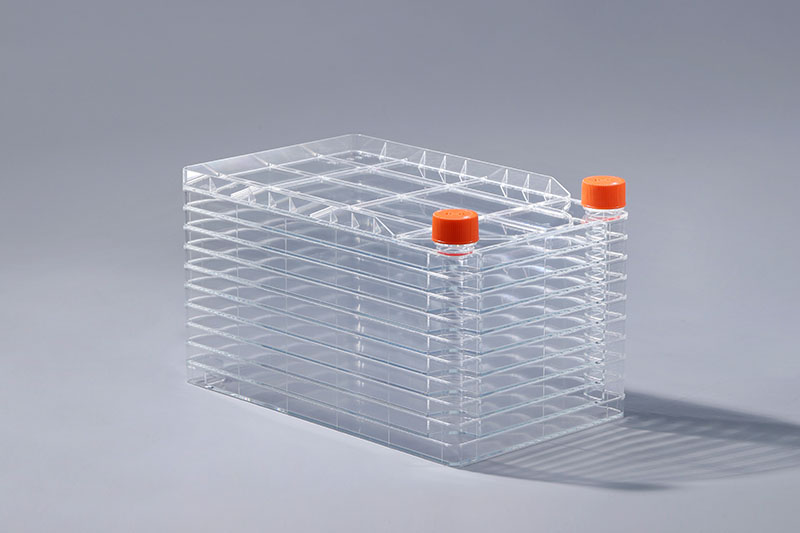Lentivirus هو نوع من الناقلات الفيروسية المعدلة من فيروس نقص المناعة البشرية (HIV) ، وهو نوع من الفيروسات القهقرية. في التجارب المختبرية والتجارب في الجسم الحي ، أصبح الفيروس البطيء أحد الأشكال الشائعة الاستخدام للنواقل للتعبير عن الجينات الخارجية أو shRNA الخارجي ، ويتم استخدامه على نطاق أوسع. في إنتاجها الضخم ، فإن يتم تطبيق مصنع الخلية بشكل أساسي على الإنتاج الموسع لنواقل الفيروسة البطيئة. يمكن أن يزيد من مساحة سطح ثقافة الخلية ، وبالتالي زيادة محصول الناقل ، وتقليل عدد مرات تعداء واستبدال الوسيط بعد تعداء ، وتقليل تكاليف العمالة. إنها ثقافة خلوية فعالة ومريحة قابلة للاستهلاك. هي ثقافة خلوية شائعة الاستخدام. تسلسل. فيما يتعلق بالعدوى ، يمكن أن تصيب الخلايا العصبية وخلايا الكبد وخلايا عضلة القلب والخلايا السرطانية والخلايا البطانية والخلايا الجذعية وأنواع أخرى من الخلايا بشكل فعال ، وذلك لتحقيق تأثيرات العلاج الجيني الجيدة. بالنسبة لبعض الخلايا التي يصعب تحويلها ، مثل الخلايا الأولية ، والخلايا الجذعية ، والخلايا غير المتمايزة ، وما إلى ذلك ، يمكن أن يؤدي استخدام نواقل الفيروسة البطيئة إلى تحسين كفاءة نقل الجين المستهدف أو shRNA المستهدف ، ويمكن للجين المستهدف أو shRNA المستهدف يتم دمجها في الخلية المضيفة. يزداد احتمال الجينوم بشكل كبير ، ويمكن تحقيق التعبير طويل المدى والمستقر للجين المستهدف أو shRNA الهدف بشكل أكثر ملاءمة وسرعة.
بالإضافة إلى تطبيقها على الإنتاج الواسع النطاق لناقلات الفيروسة البطيئة ، تلعب مصانع الخلايا دورًا مهمًا في الإنتاج على نطاق واسع للعلاج بالخلايا ، والعلاج الجيني ، وعلاج فيروس الورم. واللقاحات.
The cell factory is mainly applied to the expanded production of lentiviral vectors. It can increase the surface area of cell culture, thereby increasing the yield of the vector, reducing the number of times of transfection and post-transfection medium replacement, and reducing labor costs. It is an efficient and convenient cell culture consumable.
In addition to being applied to the large-scale production of lentiviral vectors, cell factories play an important role in the large-scale production of cell therapy, gene therapy, oncolytic virus therapy, and vaccines.
The FAI climbed 5.9 percent year-on-year in the first 11 months of 2018, quickening from the 5.7-percent growth in Jan-Oct, the National Bureau of Statistics (NBS) said Friday in an online statement.
The key indicator of investment, dubbed a major growth driver, hit the bottom in August and has since started to rebound steadily.
In the face of emerging economic challenges home and abroad, China has stepped up efforts to stabilize investment, in particular rolling out measures to motivate private investors and channel funds into infrastructure.
Friday's data showed private investment, accounting for more than 60 percent of the total FAI, expanded by a brisk 8.7 percent.
NBS spokesperson Mao Shengyong said funds into weak economic links registered rapid increases as investment in environmental protection and agriculture jumped 42 percent and 12.5 percent respectively, much faster than the average.
In breakdown, investment in high-tech and equipment manufacturing remained vigorous with 16.1-percent and 11.6-percent increases respectively in the first 11 months. Infrastructure investment gained 3.7 percent, staying flat. Investment in property development rose 9.7 percent, also unchanged.
 English
English



















































